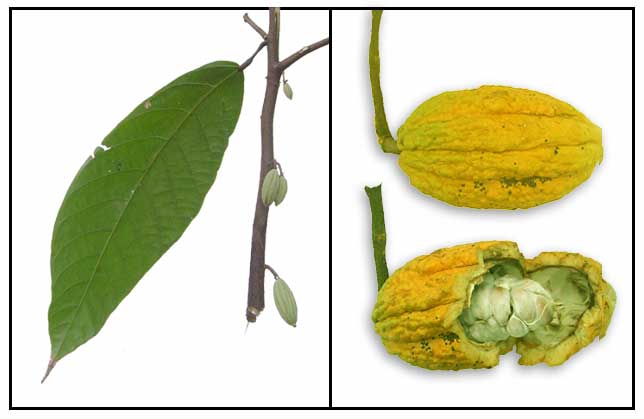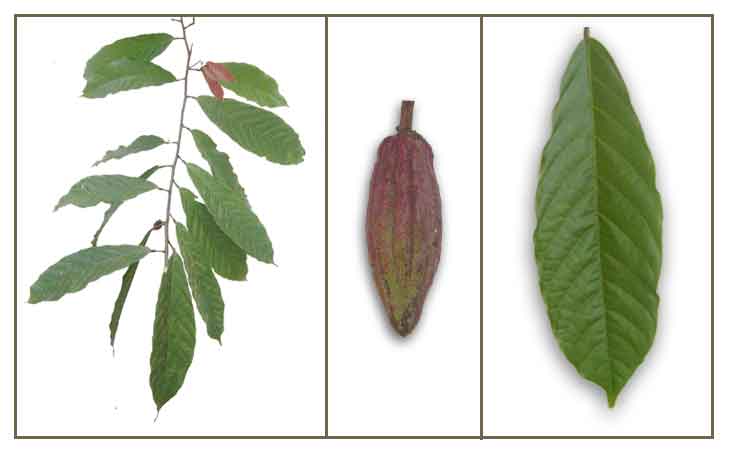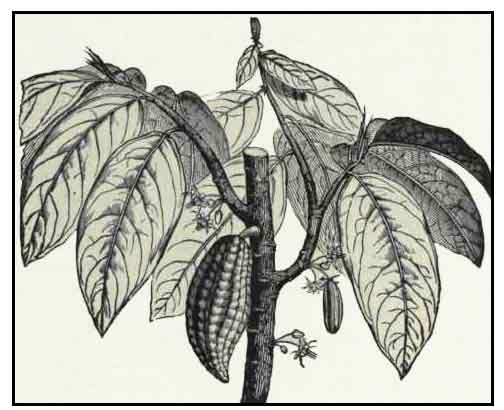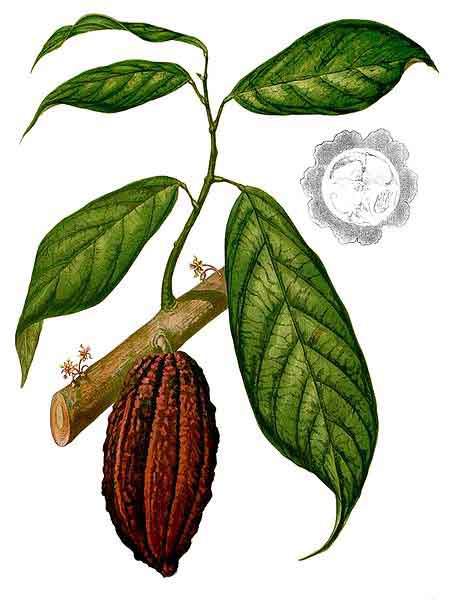Copyrights of the entry and photos belong to Stuartexchange website and as specified below:
| Photos ©Godofredo Stuart / StuartXchange |
| OTHER IMAGE SOURCE: B&W Drawing / Fig. 261. - Theobroma Cacao / Chocolate Tree / Chest of Books |
| IMAGE SOURCE: File:Theobroma cacao Blanco2.275-cropped.jpg / Francisco Manuel Blanco (O.S.A.) / Flora de Filipinas / 1880-1883 Public Domain / Modifications by Carol Spears / Wikimedia Commons |
Kakaw
Ke ke shu
| Scientific names | Common names |
| Theobroma cacao L. | Kakaw (Tag.) |
| Cacao sativa Aubl. | Cacao tree (Engl.) |
| Theobroma sativum (Aubl.) Lign. & Le Bey | Chocolate tree (Engl.) |
| Ke ke (Chin.) | Cocoa tree (Engl.) |
| Ke ke shu (Chin.) |
| Other vernacular names |
| BURMESE: Kokoe. |
| CATALAN: Cacau |
| DANISH: Kakaotrae. |
| DUTCH: Cacaoboom. |
| FINNISH: Kaakao, Kaakaopuu. |
| FRENCH: Cacao, cacaoyer. |
| GERMAN: Kakaobaum, Kakaopflanze. |
| HINDI: Kokko. |
| ITALIAN: Albero del cacao. |
| JAPANESE: Kakao, Kakao no ki, Kokoa no ki, Teoburaama kakao. |
| KHMER: Kakaaw. |
| MALAY: Pokok coklat. |
| MALAYALAM: Kokko, Kokkoo. |
| NORWEGIAN: Kakaotre. |
| POLISH: Kakaowiec. |
| PORTUGUESE: Arbore de cacao, Arvore-da-vida, Cacau, Cacau-de-mata, Cupuacu de mata. |
| RUSSIAN: Kakao, Shokoladnoe derevo. |
| SINHALESE: Maikonagaha. |
| SPANISH: Arbol de cacao, Cacahualt, Cacao amarillo, Cacao del monte, Cacaoeiro, Cacaotero. |
| SWEDISH: Kakao, Kakaobuske. |
| TAMIL: Kakkavo, Kona maram. |
| THAI: Kho kho, Ko ko. |
| TURKSIH: Hint bademi agaci, Kakao agaci. |
| VIETNAMESE: Ca cao. |

| Gen info Chocolate comes from the fruit of the kakaw tree. Kakaw's scientific name "Theobroma" means "food for the gods." In pre-Columbian times, its bean was a major currency and great trading value. Botany Kakaw is a mall tree, growing to 3 to 5 meters high. Leaves are alternate, entire, oblong-ovate to oblong, 15 to 40 centimeters long, 5 to 20 centimeters wide, with pointed tip and rounded base. Flowers are solitary or fascicled on the trunk and branches; yellowish or nearly white, about 1 centimeter in diameter. Fruit is oblong, 10 to 15 centimeters long, prominently wrinkled, yellow or purplish. Seeds are numerous and embedded in whitish pulp.  Distribution Widely scattered in cultivation at low and medium altitudes. - Cultivated for its seeds. - Nowhere spontaneous in the Philippines. - Introduced from Mexico.  Constituents Cocoa contains approximately 380 known chemicals and 10 psychoactive constituents. - Seeds contain fixed oil, 40-56 %; theobromine; glucose, saccharose; vitamin A, 825-1400 I.U. per 100 gm; cellulose, 2.8-5.4%; water, 5-7%; ash, 3-5%; starch, 5% and a glucoside, cacarine. - The mesocarp and seed contain theobromine and caffeine. - The wall and pulp of the fruit contain arabinose and galactose. -The flesh contain enzymes: protease, invertase, raffinase, cesease and oxydase. - Cacao is high in magnesium. - High in antioxidants, approximately 40 times higher than blueberries. - Possibly contains MAO inhibitors with effects on serotonin and neurotransmitters. - Contains PEA (phenylethylamine) and anandamine. - High in polyphenols, with three main groups: catechins (37%), anthocyanins (4%) and proanthocyanidins (58%). The main catechin is (-)-epicathechin with up to 35% of polyphenol content. Properties- Considered emmenagogue and ecbolic. - Emollient, diuretic, aphrodisiac, nutritive. - Theobromine resembles caffeine in action, with less powerful effects on the central nervous system. - Rich source of polyphenols, reportedly with higher antioxidant activity than teas and red wines. Parts utilizedSeed, roots, oil. Uses Edibility / Culinary - Cultivated for use in the manufacture of cacao, chocolate, cacao butter, chocolate food, drink or fruit. Folkloric - Oil or cocoa butter is an excellent emollient, used to soften and protect chapped hands and lips. - Eczema, dry skin: Roast 10-12 seeds and pound ; apply to affected areas as poultice after a warm compress. - Root decoction used as emmenagogue (promotes or stimulates menstrual flow) and ecbolic (promotes labor by stimulating uterine contractions. Others - Cocoa butter (oil of theobroma) is an excellent emollient for use to prevent chapped lips and hands. - Cacao butter used in the manufacture of confections, toilet articles and cosmetics; in pharmacy, used for pill coating and suppository preparation. Studies • Hypoglycemic: Hypoglycemic Properties of Malaysian Cocoa (Theobroma Cacao) Polyphenols Extract: Study showed that Malaysian cocoa polyphenol extract has a potential of being an insulin-mimetic agent. Further studies are suggested to elucidate on the underlying mechanisms for its glucose reduction and insulin mimicking activities. • Anti-Ulcer: Effects of polyphenol substances derived from Theobroma cacao on gastric mucosal lesion induced by ethanol: Study suggests that the antiulcer mechanism of the polyphenols was from radical scavenging and modulation of leukocyte function.  • Immune Activity: Effect of Theobroma cacao flavonoids on immune activation of a lymphoid cell line: Extract down-modulated T lymphocyte activation and the acquired immune response which could be important in autoimmune or chronic inflammatory disease. • Immune Activity: Effect of Theobroma cacao flavonoids on immune activation of a lymphoid cell line: Extract down-modulated T lymphocyte activation and the acquired immune response which could be important in autoimmune or chronic inflammatory disease.• Flavonoids / Nitric Oxide / Endothelial Function: (1) Study indicate flavanol-rich foods provide extraordinary health benefits. In populations that no longer consume large quantities of such foods, the risk of cardiac and cancer deaths have significantly increased. (2) Epicatechin, one of the bioactive nutrients in cocoa can promote blood vessel relaxation and the cardio-benefits might not be antioxidant dependent. (3) Studies have suggested the antioxidants and flavonoids in dark chocolate with benefits of lowering effects on blood pressure and LDL cholesterol levels. • Human Platelet Reactivity Modulation: Study sought to evaluate whether a 28-day supplementation with cocoa flavanols and related procyanidin oligomers would modulate human platelet reactivity and primary hemostasis and reduce oxidative markers in vivo. Results showed significant increase in plasma epicatechin and catechin concentrations and significantly decreased platelet function. • Antioxidative Polyphenols: Study isolated clovamide, deoxyclovamide, quercetin and its glucoside. In the bulk oil system, clovamide had the strongest antioxidative activity. Results suggest that chocolate is stable against oxidative deterioration due to the presence of these polyphenolic compounds. • Inhibition of NO Release / Cytokine Secretion Inhibition: Study shows that cocoa flavonoids not only inhibit NO release from macrophages but also down-regulate inflammatory cytokines and chemokines. • Polyphenols / Antioxidative Activity: Study showed the polyphenol content and its antioxidant capacity vary among a wide range of cocoa and chocolate products, with processing making a great impact on the level of polyphenols. • Antioxidative Polyphenols: Study shows that cocoa inhibits drug-triggered liver cytotoxicity and prevents apoptosis by inducing autophagy. Results suggest that cocoa can be added to the list of natural chemopreventive agents with a potential for hepatopathy prevention and therapy. • Antioxidant and Biologic Activities / Cocoa Hulls: A supercritical CO2 extraction method showscocoa hulls by-product to be a matrix rich in fiber (pectin) and phenolics. A better characterization of the bioactivity of the phenolic pigments is suggested for its potential use in food technology as functional colorant ingredient or antioxidant complex extract. |
Additional Sources and Suggested Readings (1)Medicinal value of chocolate explored by scientists / Mongabay (2)Hypoglycaemic Properties of Malaysian Cocoa (Theobroma Cacao) Polyphenols-Rich Extract / Ruzaidi, A., Abbe Maleyki et al / International Food Research Journal 15(3), (2008) (3)Effects of polyphenol substances derived from Theobroma cacao on gastric mucosal lesion induced by ethanol / OSAKABE N., SANBONGI C et al / Bioscience, biotechnology, and biochemistry / 1998, vol. 62, no8, pp. 1535-153 (4)Pentameric Procyanidins Isolated from Theobroma cacao Seeds Selectively Downregulate ErbB2 in Human Aortic Endothelial Cells / Thomas P. Kenny et al / Experimental Biology and Medicine 229:255-263 (2004) (5) Effect of Theobroma cacao flavonoids on immune activation of a lymphoid cell line (6)Dietary flavanols and procyanidin oligomers from cocoa (Theobroma cacao) inhibit platelet function / Karen J Murphy, Andriana K Chronopoulos et al / American Journal of Clinical Nutrition, Vol. 77, No. 6, 1466-1473, June 2003 (7)Antioxidative Polyphenols Isolated from Theobroma cacao / Chiaki Sanbongi et al / J. Agric. Food Chem., 1998, 46 (2), pp 454–457 / DOI: 10.1021/jf970575o (8)Flavonoids from Theobroma cacao Down-Regulate Inflammatory Mediators / Emma Ramiro et al / J. Agric. Food Chem., 2005, 53 (22), pp 8506–8511 / DOI: 10.1021/jf0511042 (9)Protective Activity of Theobroma cacao L. Phenolic Extract on AML12 and MLP29 Liver Cells by Preventing Apoptosis and Inducing Autophagy / Marco Arlorio et al / J. Agric. Food Chem., 2009, 57 (22), pp 10612–10618 / DOI: 10.1021/jf902419t (10)Sorting Theobroma names / Porcher Michel H. et al. 1995 - 2020 / MULTILINGUAL MULTISCRIPT PLANT NAME DATABASE (11)Polyphenols in cocoa (Theobroma cacao L.) / C.L. Hii, C.L. Law, S. Suzannah, Misnawi and M. Cloke / As. J. Food Ag-Ind. 2009, 2(04), 702-722 (12)Antioxidant and biological activity of phenolic pigments from Theobroma cacao hulls extracted with supercritical CO2 / M. Arlorio, J.D. Co ̈ısson, F. Travaglia et al / Food Research International 38 (2005) 1009–1014 (13)Theobroma cacao L., the Food of the Gods: A scientific approach beyond myths and claims / M. Rusconi∗, A. Conti / Pharmacological Research 61 (2010) 5–13 |
•
|



No comments:
Post a Comment